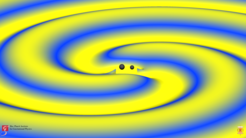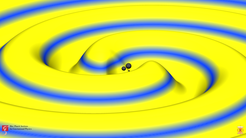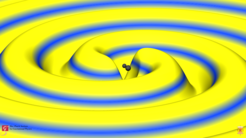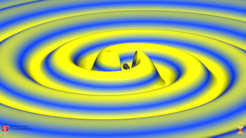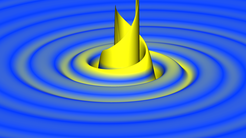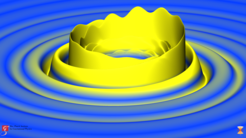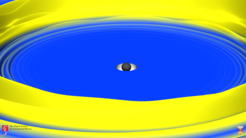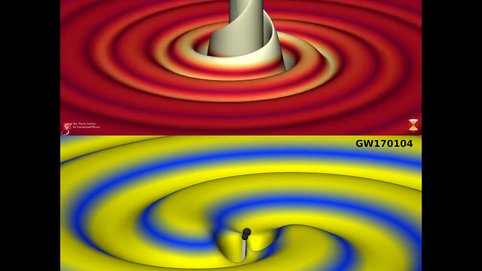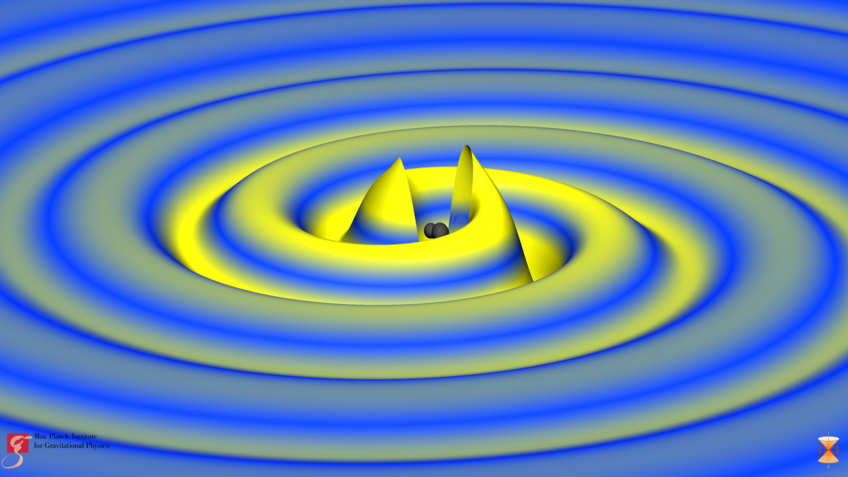
Third detection of gravitational waves on Earth: numerical simulation
The video and the images show the numerical simulation of a binary black-hole coalescence with masses and spins consistent with the GW170104 observation. The strength of the gravitational wave is indicated by elevation as well as color, with blue indicating weak fields and yellow indicating strong fields. We rescale the amplitude of the gravitational wave during the simulation to show the signal during the entire animation not only close to merger, where it is strongest. The sizes of the black holes are increased by a factor of two to improve visibility. The bottom panel in the video shows the gravitational waveform starting at frequency of 25Hz. The fade in of the video corresponds to a frequency of about 30Hz.
Note: Publication of these images and movie requires proper credits and written permission. Please contact the AEI press office in advance of publication or for higher-resolution versions.
Credit for movie and images:
Numerical relativity simulation: S. Ossokine, A. Buonanno (Max Planck Institute for Gravitational Physics), Simulating eXtreme Spacetimes project
Scientific Visualization: T. Dietrich (Max Planck Institute for Gravitational Physics), R. Haas (NCSA)
Simulation of the binary black-hole coalescence GW170104
The video shows the numerical simulation of a binary black-hole coalescence with masses and spins consistent with the GW170104 observation. The two black holes have a mass ratio of nearly 1.35, which lies in the possible predicted mass range for the binary system. The strength of the gravitational wave is indicated by elevation as well as color, with blue indicating weak fields and yellow indicating strong fields. We rescale the amplitude of the gravitational wave during the simulation to show the signal during the entire animation not only close to merger, where it is strongest. The sizes of the black holes are increased by a factor of two to improve visibility. The bottom panel shows the gravitational waveform starting at frequency of 25Hz. The fade in of the video corresponds to a frequency of about 30Hz.
Simulation of the binary black-hole coalescence GW170104
Comparison of the gravitational wave events GW150914 and GW170104
The video contrasts the two events GW150914 (upper movie panel) and GW170104 (lower movie panel). The strength of the gravitational wave is indicated by elevation and color. We rescale the amplitude of the gravitational wave during the simulation to show the signal during the entire animation and not only close to merger, where it is strongest. The sizes of the black holes are increased by a factor of two to improve visibility. The two animations for GW150914 and GW170104 start at the same gravitational wave frequency of about 25Hz, but because of the different total mass of the binaries, GW150914 merges earlier and has a smaller number of orbits until merger.
Comparison of the gravitational wave events GW150914 and GW170104
Comparison of the gravitational wave events GW150914 and GW170104
The video contrasts the two events GW150914 (left) and GW170104 (right). The strength of the gravitational wave is indicated by elevation and color. We rescale the amplitude of the gravitational wave during the simulation to show the signal during the entire animation and not only close to merger, where it is strongest. The sizes of the black holes are increased by a factor of two to improve visibility. The two animations for GW150914 and GW170104 start at the same gravitational wave frequency of about 25Hz, but because of the different total mass of the binaries, GW150914 merges earlier and has a smaller number of orbits until merger.
Comparison of the gravitational wave events GW150914 and GW170104
Images
Numerical relativity simulation of GW170104, a coalescence of two black holes

